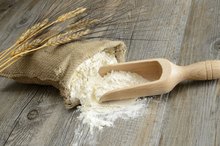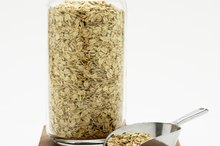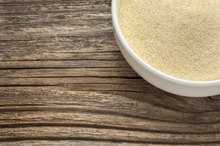What does fact checked mean?
At Healthfully, we strive to deliver objective content that is accurate and up-to-date. Our team periodically reviews articles in order to ensure content quality. The sources cited below consist of evidence from peer-reviewed journals, prominent medical organizations, academic associations, and government data.
The information contained on this site is for informational purposes only, and should not be used as a substitute for the advice of a professional health care provider. Please check with the appropriate physician regarding health questions and concerns. Although we strive to deliver accurate and up-to-date information, no guarantee to that effect is made.
Allergic to White Flour
Having an allergy to white, all-purpose flour means having an allergy to wheat. Most wheat allergies develop during the infant or toddler years, but children generally outgrow wheat allergies between the ages of 3 and 5. Allergies to all-purpose flour and other wheat products rarely develop in adulthood. If you suspect that you or a family member has an allergy to all-purpose flour, contact your doctor for an official diagnosis.
Wheat Flours
All-purpose flour is a type of wheat flour. According to Oklahoma State University's Division of Agricultural Sciences and Natural Resources, kernels of wheat consist of the bran, endosperm and germ. A miller makes whole wheat flour by grinding the entire wheat kernel but makes all-purpose flour by grinding the endosperm.
- All-purpose flour is a type of wheat flour.
- A miller makes whole wheat flour by grinding the entire wheat kernel but makes all-purpose flour by grinding the endosperm.
Wheat Allergy Overview
Wheat Bran Allergies
Learn More
As MayoClinic.com explains, in individuals with a wheat allergy, the immune system mistakenly identifies a protein found in wheat as a threat and creates an antibody in response 1. Once the immune system develops this antibody, it has a reaction whenever you consume wheat. Most individuals with a wheat allergy develop symptoms within two hours of eating. Some people only experience exercise-induced symptoms that occur if they perform moderate to heavy exercise several hours after eating a wheat-based product. Others have "baker's asthma," an allergic reaction triggered by inhaling uncooked flour but not by consuming cooked wheat products. Celiac disease -- a sensitivity to the gluten protein found in wheat -- is not technically an allergy but still prevents individuals from consuming all-purpose and other wheat flours.
- As MayoClinic.com explains, in individuals with a wheat allergy, the immune system mistakenly identifies a protein found in wheat as a threat and creates an antibody in response 1.
- Some people only experience exercise-induced symptoms that occur if they perform moderate to heavy exercise several hours after eating a wheat-based product.
Symptoms
The most common wheat allergy symptoms include:
- irritation of the mouth
- hives
- abdominal pain
- diarrhea
- nausea
- vomiting
- nasal congestion
- watery eyes
In severe cases, a wheat allergy may even trigger anaphylaxis, in which the patient experiences throat swelling, rapid pulse and severe difficulty breathing. Anaphylaxis is especially symptomatic of exercise-induced wheat allergy. Individuals with baker's asthma frequently experience hives and nasal symptoms. Celiac disease, on the other hand, primarily mimics the digestive symptoms associated with a true wheat allergy.
- The most common wheat allergy symptoms include: * irritation of the mouth
* hives
* abdominal pain
* diarrhea
* nausea
* vomiting
* nasal congestion
* watery eyes In severe cases, a wheat allergy may even trigger anaphylaxis, in which the patient experiences throat swelling, rapid pulse and severe difficulty breathing. - Celiac disease, on the other hand, primarily mimics the digestive symptoms associated with a true wheat allergy.
Flour Substitutes
Signs & Symptoms of Wheat & Whole Grain Allergies
Learn More
If your doctor diagnoses you with a wheat allergy, avoid foods made with all-purpose flour or other wheat flours. Buy food labeled as "gluten free" or made using alternative flour types. For home baking purposes, switch to using an alternative non-wheat flour. According to the Lucile Packard Children's Hospital at Stanford, 1 cup of any wheat flour equals 1 cup rye flour or rye meal, 1 cup potato flour, 1-1/3 cup oat flour, 1/2 cup potato flour mixed with 1/2 cup rye flour or 5/8 cup rice flour mixed with 1/3 cup rye flour.
- If your doctor diagnoses you with a wheat allergy, avoid foods made with all-purpose flour or other wheat flours.
Related Articles
References
- MayoClinic.com; Wheat Allergy; July 2011
- The Cook's Thesaurus: Non-Wheat Flours
- Cianferoni A. Wheat allergy: diagnosis and management. J Asthma Allergy. 2016;9:13-25. doi:10.2147/JAA.S81550
- Salcedo G, Quirce S, Diaz-perales A. Wheat allergens associated with Baker's asthma. J Investig Allergol Clin Immunol. 2011;21(2):81-92.
- Scherf KA, Brockow K, Biedermann T, Koehler P, Wieser H. Wheat-dependent exercise-induced anaphylaxis. Clin Exp Allergy. 2016;46(1):10-20. doi:10.1111/cea.12640
- Pacharn P, Vichyanond P. Immunotherapy for IgE-mediated wheat allergy. Hum Vaccin Immunother. 2017;13(10):2462-2466. doi:10.1080/21645515.2017.1356499
- Czaja-Bulsa G, Bulsa M.What Do We Know Now about IgE-Mediated Wheat Allergy in Children?Nutrients. 2017 Jan 4;9(1). pii: E35. doi: 10.3390/nu9010035.
- Pacharn P, Vichyanond P.Immunotherapy for IgE-mediated wheat allergy.Hum Vaccin Immunother. 2017 Oct 3;13(10):2462-2466. doi: 10.1080/21645515.2017.1356499.
Writer Bio
Caitlynn Lowe has been writing since 2006 and has been a contributing writer for Huntington University's "Mnemosyne" and "Huntingtonian." Her writing has also been in "Ictus" and "Struggle Creek: A Novel Story." Lowe earned her Bachelor of Arts degree in English from Huntington University.









